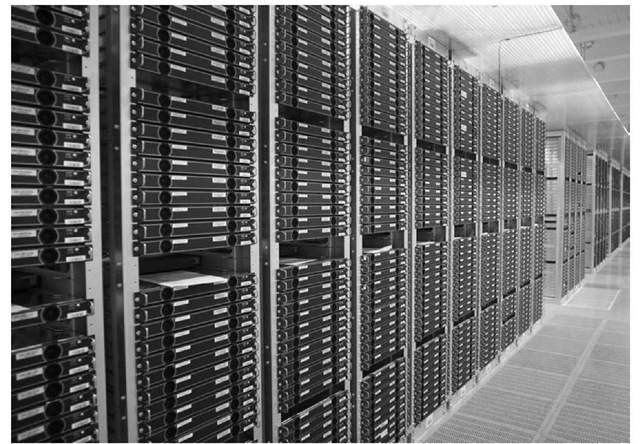At the end of each topic, we provide key implications for management that arise from the topics discussed in the topic. The implications we draw focus on improving the management of networks and information systems, as well as implications for the management of the organization as a whole.
There are three key implications for management from this topic. First, networks and the Internet change almost everything. The ability to quickly and easily move information from distant locations and to enable individuals inside and outside the firm to access information and products from around the world changes the way organizations operate, the way businesses buy and sell products, and the way we as individuals work, live, play, and learn.
Figure 1.7 One server farm with more than 1000 servers
Companies and individuals that embrace change and actively seek to apply networks and the Internet to better improve what they do, will thrive; companies and individuals that do not, will gradually find themselves falling behind.
Second, today’s networking environment is driven by standards. The use of standard technology means an organization can easily mix and match equipment from different vendors. The use of standard technology also means that it is easier to migrate from older technology to a newer technology, because most vendors designed their products to work with many different standards. The use of a few standard technologies rather than a wide range of vendor-specific proprietary technologies also lowers the cost of networking because network managers have fewer technologies they need to learn about and support. If your company is not using a narrow set of industry-standard networking technologies (whether those are de facto standards such as Windows, open standards such as Linux, or formal standards such as 802.11n wireless LANs), then it is probably spending too much money on its networks.
Third, as the demand for network services and network capacity increases, so too will the need for storage and server space. Finding efficient ways to store all the information we generate will open new market opportunities. Today, Google has almost half a million Web servers (see Figure 1.7).
SUMMARY
Introduction The information society, where information and intelligence are the key drivers of personal, business, and national success, has arrived. Data communications is the principal enabler of the rapid information exchange and will become more important than the use of computers themselves in the future. Successful users of data communications, such as Wal-Mart, can gain significant competitive advantage in the marketplace.
Network Definitions A local area network (LAN) is a group of microcomputers or terminals located in the same general area. A backbone network (BN) is a large central network that connects almost everything on a single company site. A metropolitan area network (MAN) encompasses a city or county area. A wide area network (WAN) spans city, state, or national boundaries. Network Model Communication networks are often broken into a series of layers, each of which can be defined separately, to enable vendors to develop software and hardware that can work together in the overall network. In this topic, we use a five-layer model. The application layer is the application software used by the network user. The transport layer takes the message generated by the application layer and, if necessary, breaks it into several smaller messages. The network layer addresses the message and determines its route through the network. The data link layer formats the message to indicate where it starts and ends, decides when to transmit it over the physical media, and detects and corrects any errors that occur in transmission. The physical layer is the physical connection between the sender and receiver, including the hardware devices (e.g., computers, terminals, and modems) and physical media (e.g., cables and satellites). Each layer, except the physical layer, adds a protocol data unit (PDU) to the message.
Standards Standards ensure that hardware and software produced by different vendors can work together. A formal standard is developed by an official industry or government body. De facto standards are those that emerge in the marketplace and are supported by several vendors but have no official standing. Many different standards and standards-making organizations exist. Future Trends Pervasive networking will change how and where we work and with whom we do business. As the capacity of networks increases dramatically, new ways of doing business will emerge. The integration of voice, video, and data onto the same networks will greatly simplify networks and enable anyone to access any media at any point. The rise in these pervasive, integrated networks will mean a significant increase in the availability of information and new information services such as application service providers (ASPs) and information utilities.

